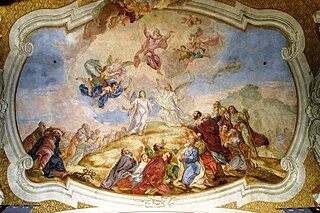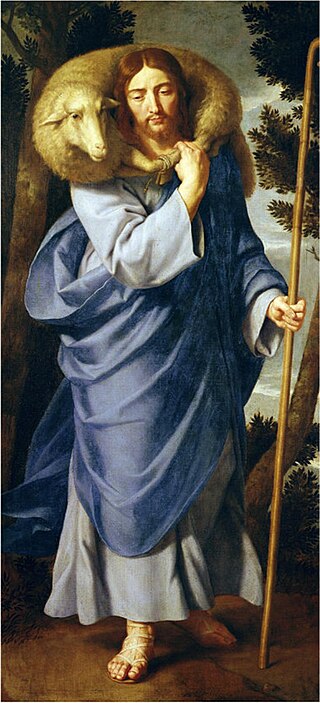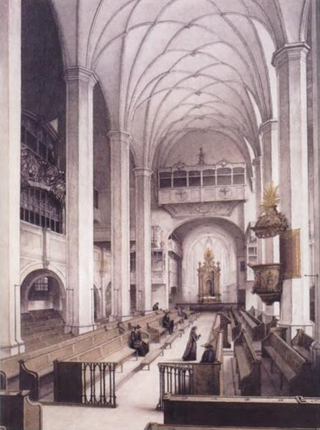Related Research Articles
Throughout his life as a musician, Johann Sebastian Bach composed cantatas for both secular and sacred use. His church cantatas are cantatas which he composed for use in the Lutheran church, mainly intended for the occasions of the liturgical year.

Lobet Gott in seinen Reichen, BWV 11, known as the Ascension Oratorio, is an oratorio by Johann Sebastian Bach, marked by him as Oratorium In Festo Ascensionis Xsti, composed for the service for Ascension and probably first performed on 15 May 1738.

The cantatas composed by Johann Sebastian Bach, known as Bach cantatas, are a body of work consisting of over 200 surviving independent works, and at least several dozen that are considered lost. As far as known, Bach's earliest cantatas date from 1707, the year he moved to Mühlhausen, although he may have begun composing them at his previous post in Arnstadt. Most of Bach's church cantatas date from his first years as Thomaskantor and director of church music in Leipzig, a position which he took up in 1723.

Wer da gläubet und getauft wird, BWV 37, is a cantata by Johann Sebastian Bach, a church cantata for the feast of the Ascension of Jesus. Bach composed it in Leipzig and first performed it on 18 May 1724.

Darzu ist erschienen der Sohn Gottes, BWV 40, is a church cantata by Johann Sebastian Bach. He composed it in 1723, his first year in Leipzig, for the Second Day of Christmas, and first performed it on 26 December that year in both main churches, Thomaskirche and Nikolaikirche. It was the first Christmas cantata Bach composed for Leipzig. The title of the cantata also appears in more modern German as Dazu ist erschienen der Sohn Gottes.
O ewiges Feuer, o Ursprung der Liebe, BWV 34.2 is an incomplete wedding cantata composed by Johann Sebastian Bach, of which only the complete libretto and some parts have survived.

Entfliehet, verschwindet, entweichet, ihr Sorgen, BWV 249a, is a secular cantata by Johann Sebastian Bach. First performed in 1725, the work is also known as "Shepherd Cantata" or "Shepherds' Cantata". Bach reworked the music in his Easter Oratorio.

Selig ist der Mann, BWV 57, is a church cantata by Johann Sebastian Bach. He wrote the Christmas cantata in Leipzig in 1725 for the Second Day of Christmas, which was celebrated that year as St. Stephen's Day, and first performed it on 26 December 1725.

Du Hirte Israel, höre, BWV 104, is a church cantata by Johann Sebastian Bach. He composed it for the second Sunday after Easter in Leipzig and first performed it on 23 April 1724.

Gelobet sei der Herr, mein Gott, BWV 129, is a church cantata by Johann Sebastian Bach. It is a chorale cantata performed on Trinity Sunday 8 June 1727 in Leipzig. Rediscovery of the printed libretto of the cantata in the first decade of the 21st century led to a re-appraisal of prior assumptions regarding the early performance chronology of a few cantatas, including this one.

Liebster Immanuel, Herzog der Frommen, BWV 123, is a church cantata by Johann Sebastian Bach. He composed the chorale cantata in Leipzig for Epiphany and first performed it on 6 January 1725. It is based on the hymn by Ahasverus Fritsch (1679).

Meinen Jesum laß ich nicht, BWV 124, is a church cantata written by Johann Sebastian Bach. He composed the chorale cantata in Leipzig for the first Sunday after the Epiphany and first performed it on 7 January 1725. It is based on the hymn "Meinen Jesum laß ich nicht" by Christian Keymann.
There are 52 chorale cantatas by Johann Sebastian Bach surviving in at least one complete version. Around 40 of these were composed during his second year as Thomaskantor in Leipzig, which started after Trinity Sunday 4 June 1724, and form the backbone of his chorale cantata cycle. The eldest known cantata by Bach, an early version of Christ lag in Todes Banden, BWV 4, presumably written in 1707, was a chorale cantata. The last chorale cantata he wrote in his second year in Leipzig was Wie schön leuchtet der Morgenstern, BWV 1, first performed on Palm Sunday, 25 March 1725. In the ten years after that he wrote at least a dozen further chorale cantatas and other cantatas that were added to his chorale cantata cycle.

Also hat Gott die Welt geliebt, BWV 68, is a cantata by Johann Sebastian Bach, a church cantata for the second day of Pentecost. Bach composed the cantata in Leipzig and first performed it on 21 May 1725. It is one of nine cantatas on texts by Christiana Mariana von Ziegler, which Bach composed at the end of his second annual cycle of cantatas in Leipzig. In a unique structure among Bach's church cantatas, it begins with a chorale and ends with a complex choral movement on a quotation from the Gospel of John. Bach derived the two arias from his Hunting Cantata.

Johann Sebastian Bach composed the church cantata Wohl dem, der sich auf seinen Gott, BWV 139, in Leipzig for the 23rd Sunday after Trinity and first performed it on 12 November 1724. The chorale cantata is based on the hymn by Johann Christoph Rube (1692).
Das neugeborne Kindelein, BWV 122, is a church cantata by Johann Sebastian Bach. Bach composed the chorale cantata in six movements in Leipzig for the Sunday after Christmas and first performed it on 31 December 1724.
Johann Sebastian Bach's chorale cantata cycle is the year-cycle of church cantatas he started composing in Leipzig from the first Sunday after Trinity in 1724. It followed the cantata cycle he had composed from his appointment as Thomaskantor after Trinity in 1723.

On Trinity Sunday 27 May 1725 Johann Sebastian Bach had presented the last cantata of his second cantata cycle, the cycle which coincided with his second year in Leipzig. As director musices of the principal churches in Leipzig he presented a variety of cantatas over the next three years. New cantatas for occasions of the liturgical year composed in this period, except for a few in the chorale cantata format, are known as Bach's third cantata cycle. His next cycle of church cantatas, the Picander cycle, did not start before St. John's Day 24 June 1728.
Late church cantatas by Johann Sebastian Bach refers to sacred cantatas he composed after his fourth cycle of 1728–29. Whether Bach still composed a full cantata cycle in the last 20 years of his life is not known, but the extant cantatas of this period written for occasions of the liturgical year are sometimes referred to as his fifth cycle, as, according to his obituary, he would have written five such cycles – inasmuch as such cantatas were not late additions to earlier cycles, or were adopted in his oratorios.
References
- ↑ Walter Blankenburg: Das Weihnachtsoratorium von Johann Sebastian Bach. 2003, pp. 34–35.
- ↑ Dinko Fabris Francesco Provenzale 2007
- ↑ David Vernier (2005). "Stölzel: Christmas Oratorio – Epistle Cantatas" (in German). ArkivMusik. Archived from the original on 10 December 2017. Retrieved 16 December 2011.
- ↑ "Edition Denkmäler Mitteldeutscher Barockmusik" (in German). mitteldeutsche-barockmusik.de. 2011. Retrieved 31 August 2011.
- 1 2 3 4 5 Benjamin G. Cohrs (2 December 2002). "Weihnachtskantaten – einmal anders" (in German). klassik-heute.com. Retrieved 8 December 2011.
- ↑ "Une Cantate de Noël". Hyperion Records. 2011. Retrieved 8 December 2011.
- ↑ "Daniel Pinkham, Christmas Cantata", choralnet.org
- ↑ Cornelis van Zwol, Anton Bruckner - Leven en Werken , Thot, Bussum (Netherlands), 2012, p. 713-714
- ↑ Uwe Harten, Anton Bruckner. Ein Handbuch. Residenz Verlag , Salzburg, 1996, p. 152-153
- 1 2 "Weihnachtskantate Komponist: Toshio Hosokawa". Schott . Retrieved 8 December 2011.
- 1 2 "Der Anfang einer neuen Zeit". Graham Waterhouse . Retrieved 7 December 2011.
- ↑ Dinko Fabris (2007). Music in seventeenth-century Naples: Francesco Provenzale (1624–1704). Ashgate Publishing. ISBN 9780754637219 . Retrieved 14 December 2011.
- ↑ "L'Adoratione de' Maggi". arkivmusic.com. 2010. Retrieved 14 December 2011.
- ↑ "Friedrich Wilhelm Zachow: Uns ist ein Kind geboren". Carus-Verlag. 2011. Retrieved 16 December 2011.
- ↑ "Fête de Noël" section at Georg Philipp Telemann, Catalogue TWV 01: Cantates d'église, Temps de Noël ( www
.musiqueorguequebec .ca ) - ↑ Spitta's Johann Sebastian Bach: Vol. I, pp. 487–491 (English version)
- ↑ RISM 454600660; RISM 450004696; RISM 230001286; RISM 250005337
- ↑ "Christian Heinrich Rinck (1770–1846)". musicweb-international.com. 2008. Retrieved 14 December 2011.
- ↑ "Ursula Vaughan Williams (obituary)". The Times . 25 October 2007.
- ↑ "Weihnachtskantate Komponist: Kurt Hessenberg". Schott. Retrieved 8 December 2011.
- ↑ John France (2004). "Nils LINDBERG (b. 1933) / A Christmas Cantata (2002)". musicweb-international.com. Retrieved 13 December 2011.